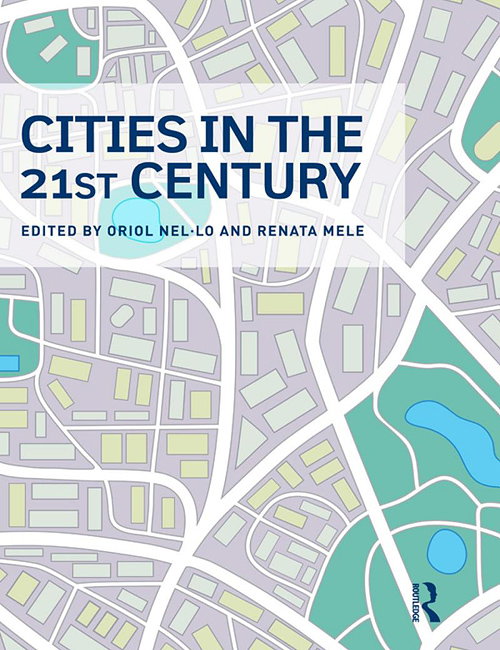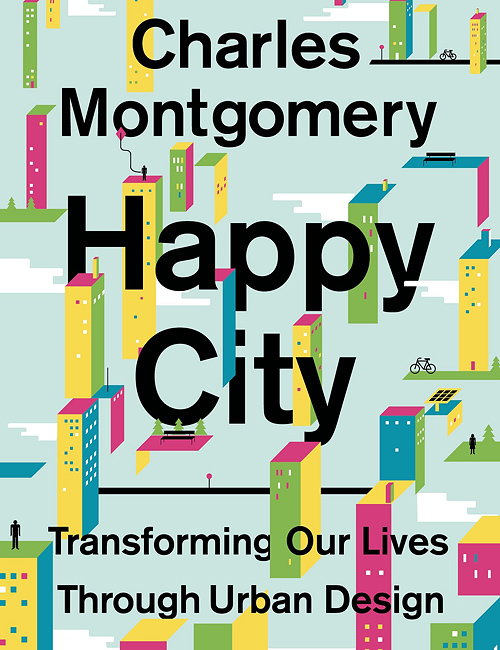Urban Design Books

Towns and Cities: Function in Form
Challenging existing assumptions about how our towns and cities are structured and formed, Julian Hart provides an engaging and thought-provoking alternative theory of urban design. This is not urban design in the sense of the practice of design; rather it is a theory of the form of the town at all scales - why towns and cities happen to be structured the way they are as a result of the social, political, legal and (especially) economic forces that create them.

Recoded City: Co-Creating Urban Futures
Recoded City examines alternative urban design, planning and architecture for the other 90%: namely the practice of participatory placemaking, a burgeoning practice that co-author Thomas Ermacora terms 'recoding'. In combining bottom-up and top-down means of regenerating and rebalancing neighbourhoods affected by declining welfare or struck by disaster, this growing movement brings greater resilience.

Cities in the 21st Century
Cities in the 21st Century provides an overview of contemporary urban development. Written by more than thirty major academic specialists from different countries, it provides information on and analysis of the global network of cities, changes in urban form, environmental problems, the role of technologies and knowledge, socioeconomic developments, and finally, the challenge of urban governance.

ArchPoetry: Urban Architecture of Malè
ArchPoetry: Urban Architecture of Malé is an architecture photo book in celebration of the beauty of the capital of the Maldives.

Building Smart Cities: Analytics, ICT, and Design Thinking
Building Smart Cities: Analytics, ICT, and Design Thinking explains the technology and a methodology known as design thinking for building smart cities. Using the principles of design thinking to reframe the problems of the smart city and capture the real needs of people living in a highly efficient urban environment, the book helps city planners and technologists through presentation of the relevant technologies required for coordinated, efficient cities; exploration of the latent needs of community stakeholders in a culturally appropriate context; and discussion of the tested approaches to ideation, design, prototyping, and building or retrofitting smart cities.

Instruments of Planning
Instruments of Planning: Tensions and Challenges for more Equitable and Sustainable Cities critically explores planning's instrumentality to deliver important social and environmental outcomes in neoliberal planning landscapes. Because each instrument is unique and may be tailored to its own jurisdictional needs, Instruments of Planning is a compendium of case studies from urban regions in Australia, Canada, the United States and Europe, providing readers with a collection that critically challenges the role and potential of planning instruments and instrumentality across a range of contexts.

Imagining New York City: Literature, Urbanism, and the Visual Arts, 1890-1940
Using examples from architecture, film, literature, and the visual arts, this wide-ranging book examines the significance of New York City in the urban imaginary between 1890 and 1940. In particular, Imagining New York City considers how and why certain city spaces-such as the skyline, the sidewalk, the slum, and the subway-have come to emblematize key aspects of the modern urban condition.

Tokyo Void: Possibilities in Absence
Tokyo's urban landscape is full of contradictions: a densely packed megalopolis, it affords thousands of vacant spaces. This volume explores possibilities for rethinking these spaces in creative ways such as "space agencies" and various architectural interventions.

Touching the City
In his new book Touching the City, architect and urbanist Timothy Makower explores how scale is manifested in cities, buildings, in the space between them and in their details and asks how scale makes a difference.

Designing the Ecocity-in-the-Sky: The Seoul Workshop
Designing the Ecocity-in-the-Sky is a comprehensive resource on vertical urbanism and how to plan and design a vertical ecocity of 100 stories. The book covers the main objectives: ecodesign, concepts, habitats, and designing for biodiversity. There are detailed drawings, diagrams, and photos that work through the technical, research, analytic, and engineering issues of ecotowers and eco-engineering designs.

Happy City: Transforming Our Lives Through Urban Design
Charles Montgomery's Happy City is revolutionizing the way we think about urban life. Rich with new insights from psychology, neuroscience, and Montgomery's own urban experiments, this book reveals how cities can shape our thoughts as well as our behavior.

City Futures in the Age of a Changing Climate
City Futures in an Age of Changing Climate looks at how cities can adapt and respond to the unsustainable conditions they are now facing. The book considers possible post-urban futures, exposing a range of very different urban forms, and addresses the concept of fragmentation; the breaking up of any coherent economic or cultural nucleic urban spaces.

The Car in 2035: Mobility Planning for the near Future
The Car in 2035: Mobility Planning for the Near Future focuses on the car, the street, and public policy in Southern California. In this collection of essays and images, the car is viewed as both a challenge and benefit to our neighborhoods, cities, and suburbs.

Ecological Urbanism: The Nature of the City
Ecological Urbanism: The Nature of the City asks the questions that are important inside and outside the built environment professions: what are climate change, urbanization and ecology doing to the theory and practice of urban design? How does Ecological Urbanism figure in this change? What is Ecological Urbanism?

Now Urbanism: The Future City is Here
Now Urbanism asserts that the future city is already here. It views city making as grounded in the imperfect, messy, yet rich reality of the existing city and the everyday purposeful agency of its dwellers. Through a framework of situating, grounding, performing, distributing, instigating, and enduring, these contributions written by a multidisciplinary group of practitioners and scholars illustrate specificity, context, agency, and networks of actors and actions in the re-making of the contemporary city.

We Own the City
We Own the City examines the ways in which urban dwellers - who used to be merely "clients" of development - are taking ownership of their neighborhoods. Bottom-up initiatives are cropping up around the world, but institutions, government offices and developers often find themselves uncertain how to collaborate with and empower these impassioned citizens and communities. Offering solutions to this disconnect, the book analyzes this international trend through five case studies, focusing on Amsterdam, Hong Kong, Moscow, New York and Taipei, each of which discusses different dynamics and intensities of citizens' redevelopment processes.

Street Design: The Secret to Great Cities and Towns
Written by two accomplished architects and urban designers, this user-friendly street design manual shows both how to design new streets and enhance existing ones. It offers step-by-step instruction and shares examples of excellent streets, examining the elements that make them successful as well as how they were designed and created. Topics also include strategies for shaping space in the public right-of-way through correct building height to street width ratios, terminated vistas, landscaping, and street geometry.

Urban Design for an Urban Century
Urban Design for an Urban Century: Shaping More Livable, Equitable, and Resilient Cities offers a comprehensive introduction to urban design, from a historical overview and basic principles to practical design concepts and strategies. The book discusses the demographic, environmental, economic, and social issues that influence the decision-making and implementation processes of urban design.

Next Generation Infrastructure
Next Generation Infrastructure takes a critical but ultimately hopeful look at how our infrastructure networks can be made more efficient, less environmentally damaging, and more resilient. The book features examples from around the world, ranging from the Mount Poso cogeneration plant in California to urban rainwater harvesting in Seoul, South Korea, to the multi-purpose Marina Barrage project in Singapore. Five bold organizing objectives are proposed that, in the hands of decision-makers and designers, will help bring about a future of multipurpose, low-carbon, resilient infrastructure that is tightly coordinated with natural and social systems.

Designing Urban Transformation
While designers possess the creative capabilities of shaping cities, their often-singular obsession with form and aesthetics actually reduces their effectiveness as they are at the mercy of more powerful generators of urban form. In response to this paradox, Designing Urban Transformation addresses the incredible potential of urban practice to radically change cities for the better.

The City as a Resource
The City as a Resource: Concepts and Methods for Urban Design proposes a model of the city as a resource containing untapped possibilities and potentials for both individuals and society as a whole. The book uses texts, projects and examples to present state-of-the-art urban planning methods and strategies for handling cities as resources, giving new life and new meaning to the idea of sustainable urban design.

The City as Interface
The City as Interface: How New Media Are Changing the City discusses the ways in which digital and mobile media are changing urban life and our everyday experience of our physical surroundings.

Handmade Urbanism
Handmade Urbanism examines the possibilities of urban transformation that stem from community initiatives. It showcases projects that focus on the provision of social infrastructure, aiming to improve the living conditions of residents in the more impoverished areas of five major cities across the world: Mumbai, São Paulo, Istanbul, Mexico City and Cape Town.

Self-Made City
Self-Made City looks at the evolving condition of architecture in Berlin, including over 40 best-practice case studies from architects such as Gruentuch-Ernst, BAR Architects, Zanderroth Architects, Ludloff + Ludloff Architects, Zoomarchitects and more.

Urban Street Design Guide
The NACTO Urban Street Design Guide shows how streets of every size can be reimagined and reoriented to prioritize safe driving and transit, biking, walking, and public activity.
Never Built Los Angeles
Never Built Los Angeles explores the "what if" Los Angeles, investigating the values and untapped potential of a city still in search of itself. This book features more than 100 visionary works that could have transformed both the physical reality and the collective perception of the metropolis, from Olmsted Brothers and Bartholomew's groundbreaking 1930 Plan for the Los Angeles Region, which would have increased the amount of green space in the notoriously park-poor city fivefold; to John Lautner's Alto Capistrano, a series of spaceship-like apartments hovering above a mixed-use development; to Jean Nouvel's 2008 Green Blade, a condominium tower clad entirely in cascading plants.
Designing Suburban Futures: New Models from Build a Better Burb
Designing Suburban Futures: New Models from Build a Better Burb shows that suburbs aren't destined to remain filled with strip malls and excess parking lots; they can be reinvigorated through inventive design. Drawing on award-winning design ideas for revitalizing Long Island, June Williamson offers valuable models not only for U.S. suburbs, but also those emerging elsewhere with global urbanization.
Shaping the City
Taking on the key issues in urban design, Shaping the City examines the critical ideas that have driven these themes and debates through a study of particular cities at important periods in their development.
American Architecture and Urbanism
A classic book authored by the foremost architectural historian in America, this fully illustrated history of American architecture and city planning is based on Vincent Scully's conviction that architecture and city planning are inseparably linked and must therefore be treated together.
Cities Are Good for You: The Genius of the Metropolis
This book critiques and awes the iconic structures of our most beloved cities and the designers that created them, revealing surprising and riveting details that will change the way we think about our cities.
